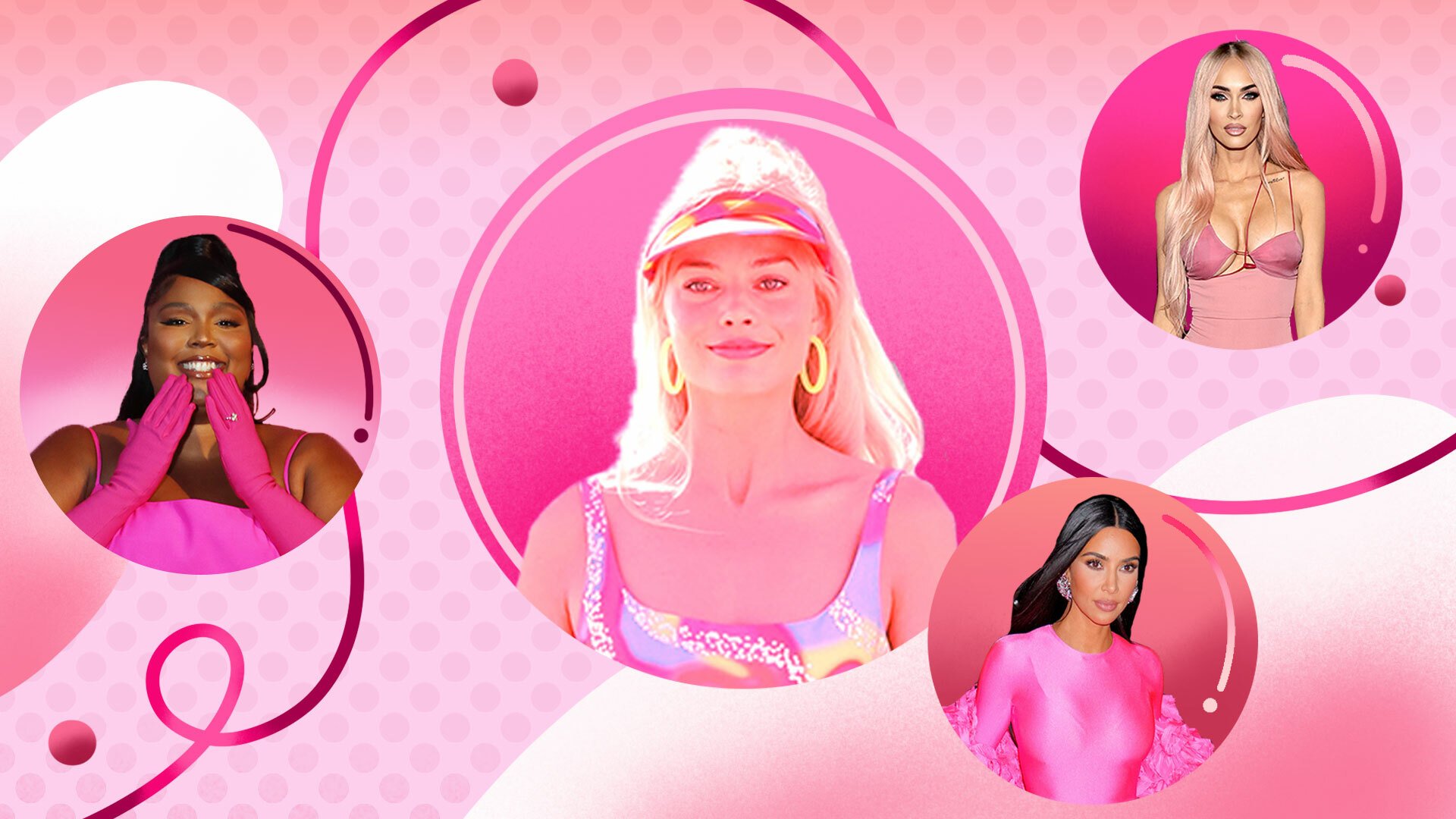
If the trend cycle has anything to say this summer, it’s that we’re living in a Barbie world. And this may not mean what it used to.
The recent rise of Barbiecore is being well-documented by celebrities, social media, and influencers. What constitutes the sub-aesthetic? Think pink: shades of watermelon, bubblegum, and kitschy fuchsia. Then the details: pink bows, rippling frills, heaps of tulle, flashing sequins, neon tights, and ostentatious pumps.
The most plausible catalyst for this trend is Greta Gerwig’s Barbie, the highly anticipated big-screen adaptation set for release in July 2023, starring Margot Robbie as the eponymous character and Ryan Gosling as her counterpart, Ken. When Warner Brothers’ dropped an official image of Robbie at CinemaCon in April, the buzz began. When the studio’s official Twitter account dropped an official sneak peek of Gosling in his Ken get-up, some saw it as a meme opportunity, while others saw it as one more step in an already bubbling craze: Barbiecore.

Credit: Jaap Buitendijk / Warner Bros.
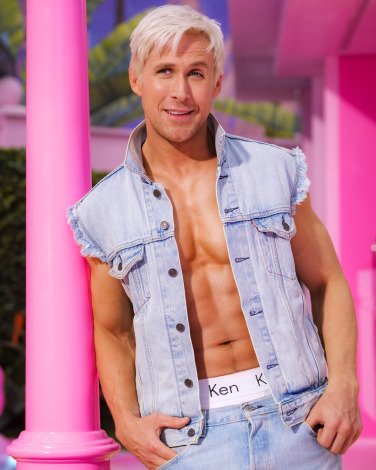
Credit: Jaap Buitendijk / Warner Bros.
In June, paparazzi shots surfaced of the stars filming on set in various locations in Los Angeles, California. On Venice Beach, they were photographed sporting ’80s acid-hued athleisure, fanny packs, and rollerblades, just like the dolls.
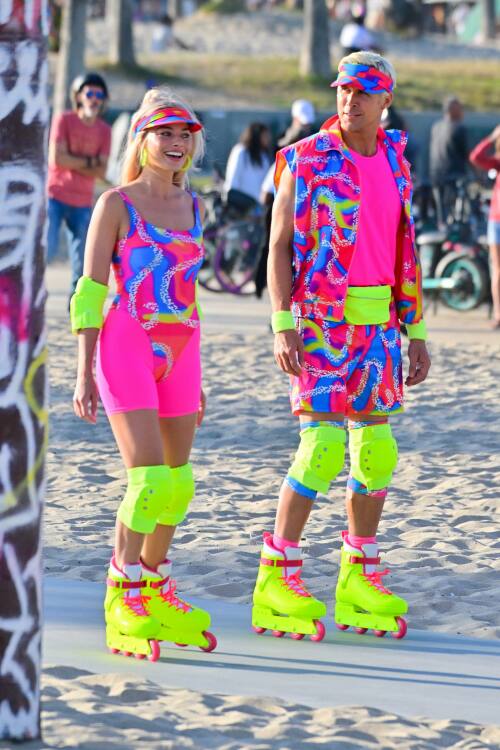
Credit: MEGA / GC Images
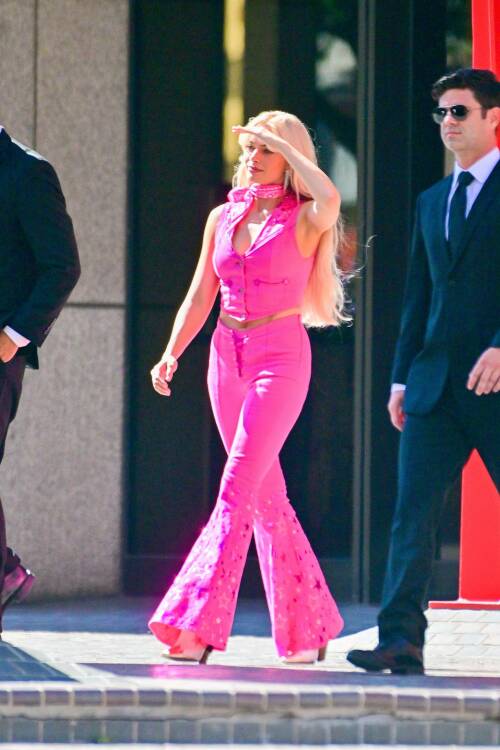
Credit: MEGA / GC Images
In tandem with Gerwig’s Barbie production, other realms of pop culture have platformed the trend. This year’s Met Gala, with the theme “Gilded Glamor and White Tie,” featured heaps of peony and princess-like fabric. A long list of well-known faces have turned up to events or posted pictures of themselves on social media wearing outfits reminiscent of a Barbie playhouse, including Kim Kardashian, Megan Fox, Lil Nas X, and Dylan O’Brien. They join the ranks of Nicki Minaj, who’s been a long-time Barbie enthusiast: it shows in her 2018 song “Barbie Dreams.” her wardrobe, and even her Instagram name (which simply reads “Barbie”).
The list goes on. Famously, Florence Pugh donned a couture, magenta ball-gown at Valentino’s Haute Couture show in July, where other prominent guests (including Ariana DeBose and Anne Hathaway) wore Barbie-esque ensembles. The brand has an affinity for pink, as confirmed by recent collections, runway appearances, and Pantone naming a color after the fashion house. The latest Valentino campaign, featuring Zendaya and Sir Lewis Hamilton, is slated in a distinctive pink, with both stars wearing the color in full ensembles. Some, like TikTokker @hellogloss, have actually theorized that Valentino’s creative director, Pierpaolo Piccioli, is the wave maker behind Barbiecore itself. Piccoli spoke of the power of pink and his vision for the color, describing the color as a manifestation of the unconscious and a liberation from the need for realism,” adding that the shade “enhances individuality, capturing values and feelings.”
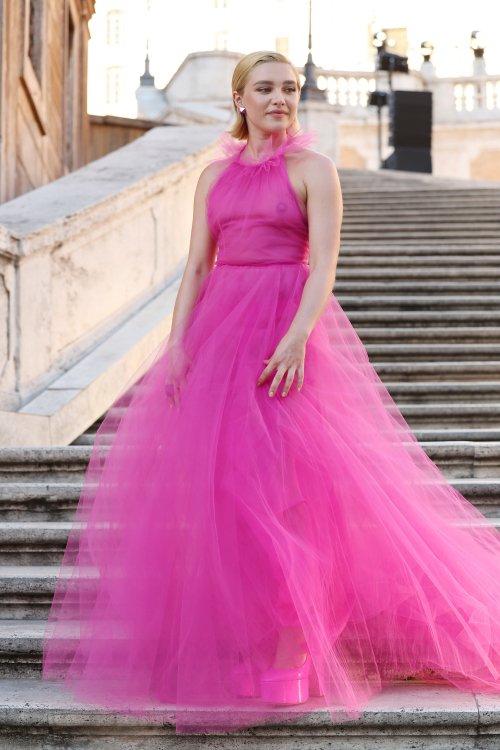
Credit: Vittorio Zunino Celotto / Getty Images
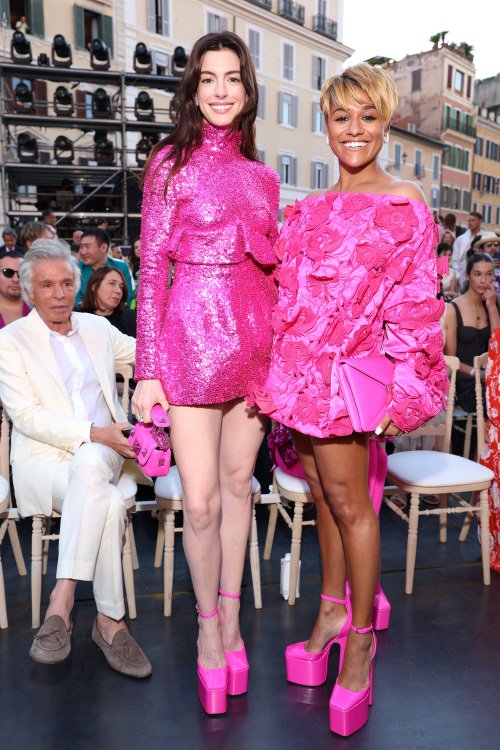
Credit: Daniele Venturelli / WireImage
The fascination with Barbiecore has reportedly led to an uptick in related purchases. Following the release of set pictures from Gerwig’s Barbie the film, sales of fuchsia and neon clothes on “buy now, pay later” platform Clearpay increased by 44 percent each in the UK. Sales of coral clothes increased by 32 percent. Other products saw rejuvenated interest, such as scrunchies, jumpsuits, and leotards.
Influencers and content creators have truly substantiated the recent Barbie phenomenon. Across Instagram, Barbie-esque colors and ensembles are popping up everywhere. On TikTok, #barbiecore content has garnered over 15.4 million views. Videos present Barbie-like outfit combinations, Barbie-inspired floral arrangements, and explainers on the trend. Some people have taken it a step further: creator @ilsefied has documented her journey to Barbie-fying her trailer, complete with a Barbie bar and themed steering wheel.
The evolution of Barbie
While aesthetically Barbiecore is faithful to its origins, the essence of the trend has diverged.
The Barbie fashion doll was released by American toy company Mattel in 1959, originally designed to be blonde, “proportioned”, and white. Its popularity soared as decades passed; in fact, 92 percent of American girls between the ages of 3 and 12 have owned a Barbie. But the doll became the subject of controversy. “Barbie doll syndrome” emerged as a medical concern — the desire for adolescent girls to resemble the traditional Barbie, who represented an overwhelmingly unattainable standard of beauty. For example, a 2016 study conducted in Australia found that exposure to Barbie had the potential to encourage young girls to internalise seeing thin bodies as an ideal.
Sales of the doll declined sharply between 2014 and 2016, perhaps as a result of a widening cultural disconnect. Finally, in 2016 itself, Mattel released three new body shapes for the Barbie doll, including curvy, petite, and tall. Since, Barbie’s evolution has only continued down a progressive path, developed to increase representation. Just this May, Mattel announced a new, diverse line of dolls, including a Barbie with a hearing aid and a Ken doll with vitiligo.
Barbiecore is not a product of Mattel itself, but the company’s cultural shift may be in line with the revived interest and redefinition of Barbie herself. With Barbiecore, traditional ideals of femininity, womanhood, and perfection continue to be subverted. The aesthetic is girly, beyond a doubt, but it can also be considered a stance on feminism. Connotations associated with Barbie have shifted, even if her propensity for pink has not.
Chazlyn Yvonne, a 21-year-old content creator, tells Mashable, “[Barbiecore is] a feminist statement that empowers women to dress how they want without fear of judgement.” She notes that this can be particularly powerful for women of color, who may not have seen themselves in the original Barbie lineup, and that the trend has helped her to “embrace femininity”.
Today, Barbiecore lies within the Venn diagram of BimboTok, fashion TikTok, and modern feminism: the aesthetic crusade urges people to embody the feminine and find joy in its playfulness — regardless of gender, race, or any other categories used by society to define a person.
Remember BimboTok? The TikTok movement started two years ago, and was a push for anyone — not just cis women — to identify as a “bimbo”. The subculture allowed the definition of the word, typically used as derogatory, to be reclaimed. A modern bimbo, as Morgan Sung wrote for Mashable, “is hyperfeminine, embraces their hotness, and rejects the capitalist mentality that they must showcase marketable skills,” defying the male gaze in the process. At the same time, this person is socially aware, competent, and doesn’t need to abide by capitalism, girlboss-culture, or societal expectations.
Barbiecore lies within the Venn diagram of BimboTok, fashion TikTok, and modern feminism.
Lauryn Jiles, a 23-year-old freelance journalist, counts herself as a long-time fan of Barbie and Barbie-inspired dressing. She cites TikTok as a stimulant for this trend, alongside the fashion industry, telling Mashable that a combination of such things “brought the Barbie aesthetic back to life”. Like Chazlyn, she agrees that the trend is “helping people tap into their feminine side”.
The idea here is that a Barbiecore-enthusiast is no longer chained to expected femininity; rather, it is a choice. Barbie-like accessories, clothing, and the color pink itself have been reclaimed as liberating, and even as symbols of strength.
Another slice of nostalgia
As the cultural evolution of a doll released in the late ’50s, nostalgia plays a major part in Barbiecore, especially with recent history. The trend shares something in common with the Tumblr 2014 aesthetic, flip phones, and wireless earphones: its current comeback has been largely prompted by Gen-Z, a generation known for its nostalgic tendencies.
It’s the not the first time we’ve seen Barbiecore emerge in recent decades — in 1997, Danish-Norwegian group Aqua dropped their mega single “Barbie Girl,” a parody which Mattel did not enjoy.
Barbiecore had a moment in the ’00s thanks to one Elle Woods (Reese Witherspoon) in Legally Blonde, whose unwavering fondness for pink had her labelled “Malibu Barbie” and severely underestimated the moment she walked onto the Harvard campus. With Legally Blonde 3 set for release in 2023, the same year as Barbie, this trend is here to stay for now.
“Nostalgia is known to spark joy and for many, Barbie brings back positive memories from childhood, so I expect Barbiecore to continue to be popular,” fashion psychologist Shakaila Forbes-Bell tells Mashable.
When it comes to technology, fashion, and entertainment, Gen-Z are continuously enthralled by the past, turning to older decades, trends, and genres. Many in their 20s crave what they perceived as a simpler time. Barbiecore fits into this greater desire.
Malvika Sheth, a 23-year-old creator who has created #Barbiecore content, says the trend is “rooted in an overly optimistic fantasy world” and supplies a sense of escapism.
“I, personally, love that it makes me nostalgic of my younger, more playful years, where things seemed almost ‘perfect’, and I had less to worry about. That feeling often does allow me to function at my optimal,” Sheth tells Mashable.
Chazlyn, similarly, says “the element of nostalgia” initially pulled her towards trying out Barbiecore. She cites Barbie movies that she grew up watching: the likes of Barbie as Rapunzel, Barbie as the Princess and the Pauper, and Barbie of Swan Lake.
“As an adult, it’s fun to add elements of that into my wardrobe,” Chazlyn says.
The Barbie renaissance this summer is, really, a power move for all those embracing it. And if we’re going to be living in a Barbie world until Gerwig’s film drops next summer, it is certainly a new one: frilly, feminine, but revitalized.
